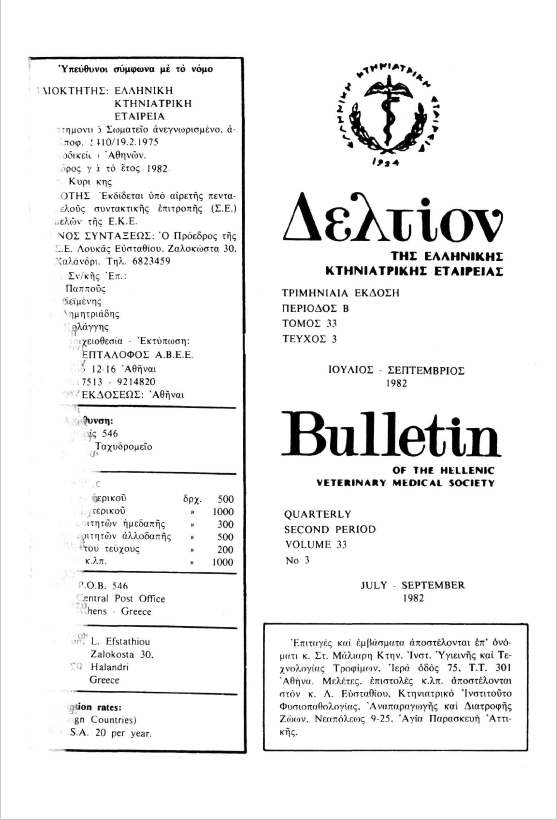Μείωση της θερμοαντιστάσεως των μικροβίων δια της προσθήκης πολυφωσφορικών άλάτων στα κρεατοσκευάσματα
Résumé
1. Εξετάσθηκε ή επίδραση τών διφωσφορικου δινατρίου (Dinatriumdiphosphat), τριπολυφωσφορικοΰ νατρίου (Natriumtripolyphosphat) και του κιτρικού τρινατρίου (Trinatrium-citrat) έπί τής μειώσεως τής θερμοαντιστάσεως τών μικροοργανισμών, Lactobacillus helveticus, Bacillus cereus και Clostridium sporogenes στά αλλαντικά καί τα βραστά χοιρομήρια. 2. Τα όλιγοφωσφορικά ευνοούν τήν θανάτωση τών ένοφθαλμισθέντων μικροοργανισμών κατά τήν θέρμανση τών βραστών αλλαντικών. Είδική ανασταλτική ενέργεια έπί τής αναπτύξεως τών μικροβίων δέν παρατηρήθηκε κατά την συντήρηση τών αλλαντικών σέ θερμοκρασία 15°C. Ή έπί τών ένοφθαλμισθέντων μικροοργανισμών επίδραση τών όλιγοφωσφορικών αλάτων παρατηρήθηκε καί έπί τής Ο,Μ.Χ. τών αλλαντικών. Ή επίδραση τοΰ διφωσφορικοΰ ήτο κάπως ίσχυρώτερη. Ή αντικατάσταση τοΰ νιτρικοΰ άλατος (NPS) μέ χλωριούχο νάτριο (NaCL) δέν έδωσε σέ καμία περίπτωση διαφορές. 3. Στά βραστά χοιρομήρια προκαλοΰν τό τριπολυφωσφορικό νάτριο καί το κιτρικό τρινάτριο σαφή μείωση τής θερμοαντιστάσεως τών ένοφθαλμισθέντων μικροβίων, άδυνατοΰν ομως να εμποδίσουν τήν ανάπτυξη αυτών. Ή επίδραση αυτή διαπιστώθηκε καί έπί τής Ο.Μ.Χ. τών χοιρομηρίων. 4. Όπως άνεμένετο, ή περιεκτικότητα σέ ύδωρ τών μέ τριπολυφωσφορικό νάτριο παρασκευασθέντων χοιρομηρίων ήτο ύψηλώτερη καί αυτή σέ λίπος και πρωτεΐνη λίγο χαμηλώτερη τοΰ κανονικού. 5. Οί απώλειες τών χοιρομηρίων σέ βάρος, έκ τοΰ βρασμού, υπήρξαν γενικά σχετικά υψηλές, διότι τά χοιρομήρια δέν υπέστησαν τήν μάλαξη, καί μάλιστα στά μέ τριπολυφωσφορικό νάτριο παρασκευασθέντα κατά τι χαμηλώτερες άπ' δτι στά υπόλοιπα. 6. Εκπληκτικά ευνοϊκή ήτο ή εκτίμηση τοΰ χρώματος, τής συστάσεως και τής γεύσεως τών μέ τριπολυφωσφορικό νάτριο παρασκευασθέντων βραστών χοιρομηρίων
Article Details
- Comment citer
-
ΒΑΤΣΟΣ Ε. Α. (2019). Μείωση της θερμοαντιστάσεως των μικροβίων δια της προσθήκης πολυφωσφορικών άλάτων στα κρεατοσκευάσματα. Journal of the Hellenic Veterinary Medical Society, 33(3), 226–232. https://doi.org/10.12681/jhvms.21546
- Numéro
- Vol. 33 No 3 (1982)
- Rubrique
- Articles

Ce travail est disponible sous licence Creative Commons Attribution - Pas d’Utilisation Commerciale 4.0 International.
Authors who publish with this journal agree to the following terms:
· Authors retain copyright and grant the journal right of first publication with the work simultaneously licensed under a Creative Commons Attribution Non-Commercial License that allows others to share the work with an acknowledgement of the work's authorship and initial publication in this journal.
· Authors are able to enter into separate, additional contractual arrangements for the non-exclusive distribution of the journal's published version of the work (e.g. post it to an institutional repository or publish it in a book), with an acknowledgement of its initial publication in this journal.
· Authors are permitted and encouraged to post their work online (preferably in institutional repositories or on their website) prior to and during the submission process, as it can lead to productive exchanges, as well as earlier and greater citation of published work.



